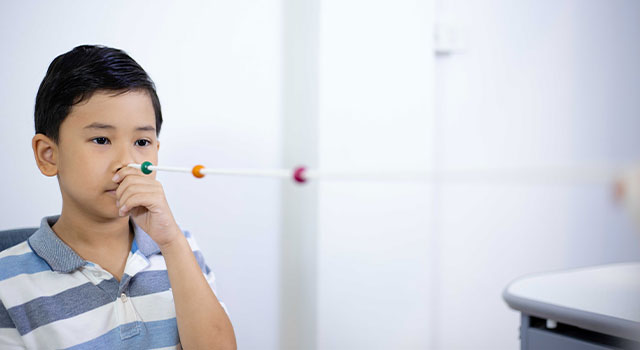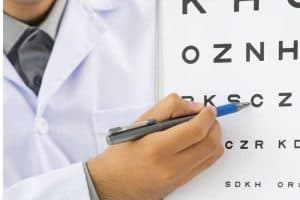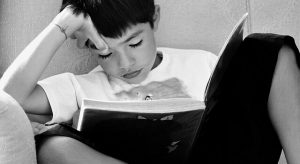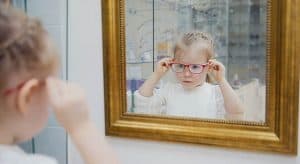Over 25% of all children have a significant vision problem that impacts their learning (American Optometric Association).
Your child’s education and happiness means everything to you. Undiagnosed vision problems could pull them down in school and in life.
Visual problems have the potential to make learning much more difficult for your child, often affecting the quality of their education and potentially their sense of self-esteem.
Vision therapy is an evidence-based program that can dramatically help a child with learning difficulties.
Here are 8 of our top frequently asked questions about vision therapy and your child’s ability to learn:
Q1: What is vision therapy?
Vision therapy is an individualized treatment program that utilizes a wide range of eye exercises to help your child steadily improve their visual skills.
Performed under the supervision of an eye doctor, vision therapy helps strengthen coordination between the brain and the rest of the visual system.
A typical vision therapy program involves both in-office therapy sessions and at-home exercises to reinforce the skills worked on with the doctor. Patients who commit to both achieve the best results.
Q2: How do visual problems impact a child’s learning?
Vision problems can affect every aspect of a child’s learning, including reading, writing and spelling. If your child’s vision is compromised then it is highly likely that their academic performance will suffer.
Among many aspects of everyday learning, vision problems can impact:
- Attention and concentration
- Classroom performance
- Handwriting
- Homework completion
- Reading fluency
- Reading comprehension
- Spelling
- Visual arts
Q3: How can vision therapy help improve my child’s learning?
Oftentimes, a student struggles in an educational environment when trying to perform certain learning activities because their eyes have trouble focusing or they’re eyes don’t work together as a team.
Many vision problems affecting a student’s learning are not related to ‘20/20 eyesight,’ but rather with their visual skills – this is where vision therapy is essential.
Vision therapy specifically addresses issues relating to visual pathways, visual efficiency, and information processing. Your eye doctor will give your child a thorough eye exam to find where they’re having difficulty, and will then create a detailed plan for how to address these issues.
These can include corrective, therapeutic or prism lenses; eye patches or occluders, electronic devices, computer software, balance boards, and many other kinds of training devices which involve integrating visual and motor skills.
Q4: How do I know if vision therapy could help my child in school?
Strong visual skills are absolutely essential to be successful in all areas of learning.
The best way to find out if your child is suffering from a vision problem that can be addressed with vision therapy is to schedule an functional eye exam for a comprehensive evaluation of their visual skills.
According to the American Optometric Association (AOA) over 1 in 4 of all children have a vision problem significant enough that it impacts their learning.
If your child is among the 25% of children with significant vision problems, especially their visual skills, it can seriously impact their ability to learn, affecting not only their academic success, but their confidence as well.
Contact an eye doctor near you to learn more about vision therapy.
SEE RELATED: Does My Child Have Dyslexia?
Q5: How can vision therapy help my child’s handwriting improve?
If your child’s teacher is complaining that their handwriting is illegible or isn’t improving, their eye doctor may create a vision therapy program that strengthens visual skills commonly associated with handwriting.
These visual skills include:
Visual perception
A vision therapy plan that addresses visual perception will help your child visualize letters and words, including their shapes and sizes.
This will then trigger a subconscious motor response that enables your child to write the letters and words they see in their mind’s eye on the paper. Children who struggle with this skill will have a hard time writing legibly.
Fine visual motor skills
A vision therapy plan that addresses these skills will help your child write neatly, with letters that are appropriately sized for the work being done.
Issues with fine visual motor skills can cause your child to press too hard on the page when writing. This can lead to muscle fatigue and soreness in the hand or wrist.
These two visual skills are necessary in combination to ensure that letters are consistently sized, written within the lines and in proper sequence, and are spaced appropriately. They help to ensure the legibility of your child’s school work.
Q6: How can vision therapy help my child’s reading improve?
If your child is having trouble reading, your eye doctor can create a program of vision therapy that can strengthen the visual skills necessary for improved reading fluency.
These skills include:
Saccades
Working on this skill means helping your child with fluid reading. This skill allows your eyes to move smoothly across a line of text, accurately and in coordination.
A difficulty with saccadic eye movements may cause a child to miss words in a sentence, or make incorrect word assumptions that can change the meaning of the sentence or passage.
Visual integration
Working on this skill will allow your child to read words more accurately by identifying the shape of each letter as well as the order of the letters in a word.
Without this skill, children often confuse letters such as b and d, or p and q or they may also confuse words such as ‘saw’ and ‘was’.
Q7: Can vision therapy help with symptoms of ADD/ADHD?
Undetected vision problems can show the same behaviors and symptoms of ADD/ADHD.
Because ADD and ADHD conditions are very familiar to the public, including to pediatricians, teachers, and school nurses, children can be incorrectly diagnosed with ADD or ADHD, and put on medication or given educational interventions when, in fact, a treatable vision problem, such as poor eye tracking or convergence insufficiency, is actually a cause of these problems.
According to a multi-site scientific study done by the National Institutes of Health/National Eye Institute, in-office vision therapy is the proven best treatment for many common childhood vision issues that are commonly mistaken for ADD/ADHD.
The study found that after 12 weeks of therapy, 75 percent of children who were given office-based vision therapy along with at-home reinforcement had significantly fewer symptoms.
Given the overlap in symptoms, and the high incidence of misdiagnosis, parents whose children are struggling in school should have their children assessed for undiagnosed vision issues that may be contributing to or mistaken for symptoms of ADD/ADHD.
Q8: How young can my school-age child start vision therapy?
Strong visual skills are an essential part of your child’s success from their very first years in school.
Fortunately, children as young as 4 years old can benefit from vision therapy.
In cases where children start at an early age, parents need to be ready to help keep their child on schedule with their in-home exercises and encourage them to participate in in-office sessions as fully as possible. Young children whose parents help them out in this way often experience very encouraging results.
LEARN MORE: Vision for School
Contact an eye doctor near you to learn more about vision therapy.










